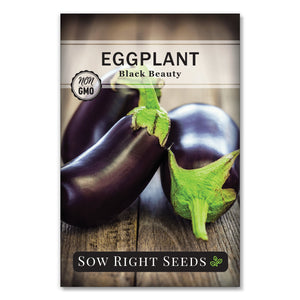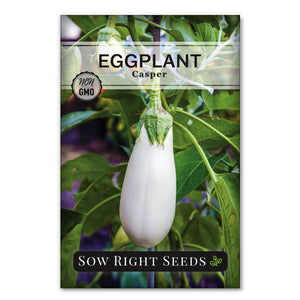When and How to Grow Eggplant from Seed for a Perfect Harvest
EggplantEggplant is a popular warm-weather vegetable. With the right environment, it's easy to grow from seed. Follow our helpful seed germination and growing tips for a delicious harvest of healthy eggplants.

Eggplant is a beautiful plant that can be grown in containers just for the visual effect. In fact, it was only grown as an ornamental for many years and not eaten at all. Now studies show eggplant to be a healthy fruit that is high in fiber and an excellent source of potassium, manganese, copper, thiamin, and vitamin B6.
This heat-loving plant is the perfect garden choice in locations with long, hot summers. If you love Eggplant Parmesan, Baba Ghanoush, or any other dish with eggplant, you’ll want to grow your own. With fresh eggplant growing in your garden, you can pick at the prime of its flavor and texture. With our eggplant growing guide, we’ll help you have a successful harvest.

How to Grow Eggplant From Seed
It is best to start eggplant seeds indoors. While it’s possible to sow eggplant seeds directly into a garden, the warm temperatures needed for it to grow usually require eggplant to be started indoors.
Eggplant Seed Germination Tips
- Start eggplant seeds indoors 8 to 12 weeks before the last spring frost.
- Plant seeds 1/4” deep in moist seed starting mix.
- Keep the seeds moist with a humidity dome.
- Use a heat mat to warm the soil between 75º to 85º F.
- Seeds should start sprouting in 7 to 14 days.
- Place grow lights close to the seedlings so they won’t grow tall and spindly but instead develop stronger plant stems.
- As seedlings grow, they will need to be “potted up,” which means putting them in larger containers. Take care not to disturb the roots when doing this.

How to Transplant Eggplant Seedlings
- 6 to 8 weeks after sprouting, eggplant seedlings should be large enough for transplanting.
- To be sure your seedlings won’t get too cold, wait until outside temperatures are above 60ºF before planting them outdoors.
- Take the time to harden them off gradually. Doing this slowly will ensure they will have a successful transition. For example, start with just a half hour outside the first day. Then slowly increase the time over a week or more to get them acclimated to a full day of sun.
- You can use row covers for additional warmth during this time and until the temperatures get too warm. Row covers will also help protect the eggplant from pests.
- Choose a location where the eggplants will have direct sunlight for at least 6 hours daily.
- Prepare the outdoor soil before transplanting the eggplant. At least a week before transplanting, add organic material to create nutrient-rich soil that will drain well.
- The optimal soil pH is between 5.5 and 7.
- Space plants 24” to 36” apart to give them room to grow.
- Add mulch and supports when first putting out seedlings, when it’s easier and won’t disrupt the plants.

Eggplant Growing Tips
- Eggplant needs to be grown in a location where it can get full sun, which means more than 6 hours of direct sunlight most days.
- Eggplant needs two months of night temperatures at or above 70º F.
- Warm soil is essential for successfully growing eggplant. The earth should be at least 70º F. In some locations, you will need to use black plastic to help warm up the soil. The black absorbs heat during the day and keeps it in the ground at night.
- Eggplant grows best in slightly acidic soil with a pH of 5.5 to 7.
- Sufficient water is important for the developing fruits since eggplant becomes bitter when it doesn’t have enough water. Eggplants will need at least an inch of water a week. During the hottest months, the plants will need even more water and should be watered 2 to 3 times a week. Keep the soil consistently moist for the best flavor and growth.
- When watering, take care to put the water on the soil without getting the leaves wet.

- Every few years, you will need to rotate the planting location of your eggplants. It is helpful to plant in spaces where beans or peas were the previous year, since they put nitrogen back into the soil.
- Eggplant grows as a bush plant, but the fruit can get heavy, so you will want to plan for a trellis or supports for big varieties.
- The use of row covers will help protect eggplants from pests.
- Using diatomaceous earth will help against flea beetles.
- Eggplant fruits don’t easily pull off like tomatoes. So instead, use pruning shears or a sharp knife to cut them off. Leave an inch of stem on the fruit when harvesting.
- Harvest eggplants frequently to encourage more production.

Harvesting Eggplant
When is eggplant ripe?
Figuring out the best time to harvest an eggplant takes some practice. The young fruits that don’t have fully developed seeds are the best tasting. This is usually around 70 to 80 days after transplanting.
The confusion about when to pick an eggplant comes because you should actually pick eggplant fruits before they are fully ripe. They should be young and slightly under-ripe for the best flavor and texture.
The finger pressure test and glossy color are two ways to help check eggplant ripeness.
First, check the gloss of the eggplant. Regardless of the color, it should have a glossy finish. Once the skin turns dull, it is past its prime eating stage.
For the finger test, apply pressure to the eggplant fruit. It should feel spongy and spring back. If there is no give, then it’s not quite ready. However, it is overripe if your finger leaves an indentation that doesn’t bounce back.
Once you cut an eggplant open, you can check the seeds to see if it’s ripe. The perfect eating stage is when there are visible seeds. But if the seeds are hard and dark, then the eggplant is overripe.
As you get a sense of what the optimal eggplant looks and tastes like, you will want to err on the side of harvesting young. This is because the slightly immature fruit tastes better since the older fruits become bitter.
Heirloom Eggplant Varieties
Black Beauty Eggplant

The classic, heirloom variety of eggplant is Black Beauty. This variety has large, dark purple glossy fruits in the traditional eggplant bell shape. These fruits can get large, and the average weight is 2 lbs. This will be a prolific producer all season, with fruits ready to harvest 75 days after transplanting.
Long Purple Eggplant

For a mild-flavored fruit that is perfect for slicing, try Long Purple eggplant. This is a prolific Italian-style eggplant with glossy purple skin and white flesh. It is ideal for adding to your favorite Italian and Asian recipes.
Casper Eggplant

White varieties, like this Casper eggplant, are known for lacking the bitterness of other colorful varieties. Casper eggplant has a mushroom-like, umami flavor. This French heirloom is best harvested at 6" long while the skin is still thin and tender. Widely adapted throughout the United States and suitable for growing in any zone.
Rosa Bianca

Rosa Bianca is a mix between purple and white. The fruits are 5-6" in diameter and have a creamy consistency prized by gourmet chefs. This Italian heirloom variety is a prolific producer in regions with warm nights.

Eating Eggplant
Eggplant discolors quickly after it is cut open, like apples. Depending on how it will be used in your recipe, you can apply salt, vinegar, or lemon juice to keep it from darkening before you are ready.
Eggplant loses its freshness quickly and does not freeze well. Don’t wash the fruits until you are ready to use them. Eggplant can be stored in the refrigerator for about three days.
Eggplant can be prepared in a variety of ways. It is popular in breaded, grilled, roasted, or fried forms, such as Baba ghanoush or the classic Eggplant Parmesan.

Eggplant Growing FAQs
Can eggplant be grown in containers?
Eggplant is such a beautiful plant that it makes an excellent container plant for a patio. Planting eggplant in a large container of around 5 gallons will give it room to grow and produce fruit.
Are there companion plants for eggplant?
Flea beetles are a common pest of eggplant. So a good companion plant is radish. The radish leaves are even more attractive to the flea beetles, and they will go there to eat and leave the eggplant leaves alone.
When should I plant eggplant?
Eggplant loves hot weather. It needs two months of warm nights with temperatures above 70ºF. So plant your eggplant seeds indoors to get the seedlings ready to transplant when the weather is consistently warm.
Eggplant is such a beautiful plant to grow. If you’re looking for a plant that will give you a successful harvest in a long, hot summer, try eggplant.
With the different varieties available, you can experiment to find which one you enjoy the most. Now’s the time to try growing this beautiful plant and taste how delicious homegrown eggplant can be.








Leave a comment